Draping in sewing is a dynamic and artistic technique that forms the cornerstone of fashion design and garment creation.
It’s a method where fabric is sculpted directly onto a three-dimensional form, such as a dressmaker’s mannequin, to conceptualize, refine, and create clothing patterns.
Unlike traditional flat pattern-making, draping allows designers to see and manipulate how fabric behaves in real time, fostering creativity and precision.
This tactile approach permits adjustments on the fly, ensuring the perfect fit and drape for the final garment.
Draping is a bridge between a designer’s vision and the tangible creation of garments, making it an essential skill in the world of fashion and couture.
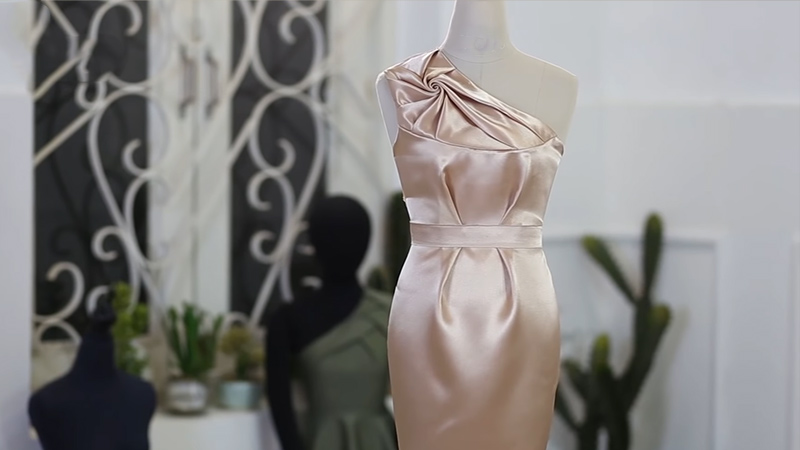
What Is Draping in Sewing?
Draping in sewing is a fundamental technique used by fashion designers and garment makers to create clothing patterns directly on a dress form or mannequin.
It’s an essential step in the process of designing and constructing garments, allowing designers to experiment with fabric, fit, and design elements in a three-dimensional form.
Draping is also known as “moulage” in some fashion circles, particularly in European fashion schools.
Here’s a closer look at what draping entails in the world of sewing and fashion design:
The Dress Form
Draping begins with the use of a dress form or mannequin. These forms are shaped to resemble the human body, and they come in various sizes and shapes to match different body types and proportions. They serve as a canvas for the designer’s creative vision.
Choosing the Fabric
Designers select the fabric they intend to use for their garment. This choice is crucial because different fabrics drape differently. Lightweight and flowy fabrics like silk and chiffon will behave differently than heavier fabrics like denim or wool.
Pinning and Manipulating the Fabric
The designer starts by pinning the chosen fabric onto the dress form. They use pins to secure the fabric in place, and then they begin to manipulate it to create the desired shape and design.
This manipulation includes folding, tucking, pleating, and gathering the fabric to achieve the desired silhouette.
Creating Seams and Details
As the fabric is draped, the designer marks and creates seams, darts, and other design elements directly on the fabric. This process involves precision and attention to detail, as the designer is essentially sculpting the garment in real time.
Refinement and Iteration
Draping is an iterative process. Designers continually adjust and refine the fabric until they are satisfied with the design, fit, and overall look of the garment.
This process allows for a high level of creativity and experimentation, as designers can make changes on the fly.
Pattern Creation
Once the draping process is complete and the designer is happy with the results, they remove the fabric from the dress form and use it as a template to create a paper pattern. This pattern serves as a blueprint for cutting and sewing the actual garment.
Sewing the Garment
After the pattern is created, the designer can proceed to cut the fabric and sew the garment together following the pattern’s guidelines.
Because the fabric was draped directly on a three-dimensional form, the resulting garment is more likely to have a good fit and drape.
Types of Draping
Draping is a versatile technique in the world of fashion design, and there are several types or methods of draping used to create various styles and garments.
Here are some common types of fabric draping techniques:
Basic Draping
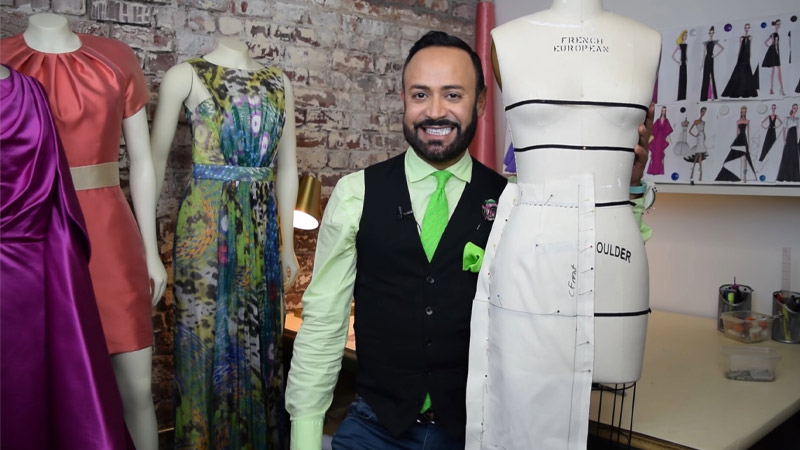
This is the foundational draping technique where designers create a basic bodice or dress shape on a dress form.
It’s often used as a starting point for more complex designs. Basic draping is essential for understanding garment construction.
Asymmetrical Draping
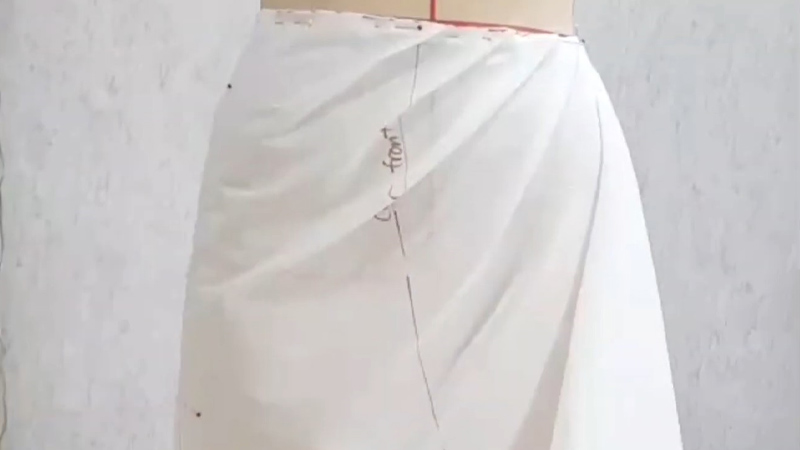
As the name suggests, this technique involves creating garments with uneven or asymmetrical elements.
Designers use this method to craft unique and innovative designs where one side of the garment differs significantly from the other.
Gathered Draping
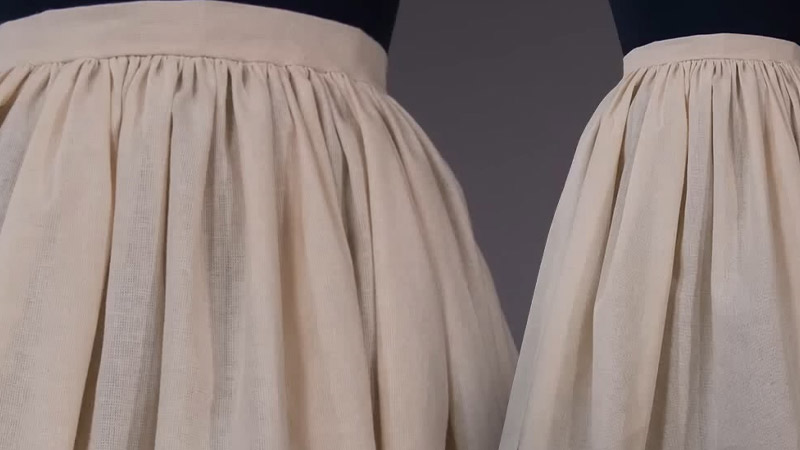
Gathered draping involves gathering or bunching fabric to create fullness or texture in specific areas of a garment. It’s commonly used in creating ruffles, pleats, and gathers in dresses, skirts, and sleeves.
Bias Draping
Draping fabric on the bias involves positioning it at a 45-degree angle to the grain line of the fabric.
This technique allows for garments with more stretch and fluidity, resulting in a flattering fit and drape. Bias-cut dresses are known for their elegant, slinky silhouette.
Cowl Draping
Cowl draping creates draped folds or “cowls” of fabric, often in the neckline or back of a garment. This technique adds a sense of elegance and fluidity to dresses and tops.
Pleated Draping
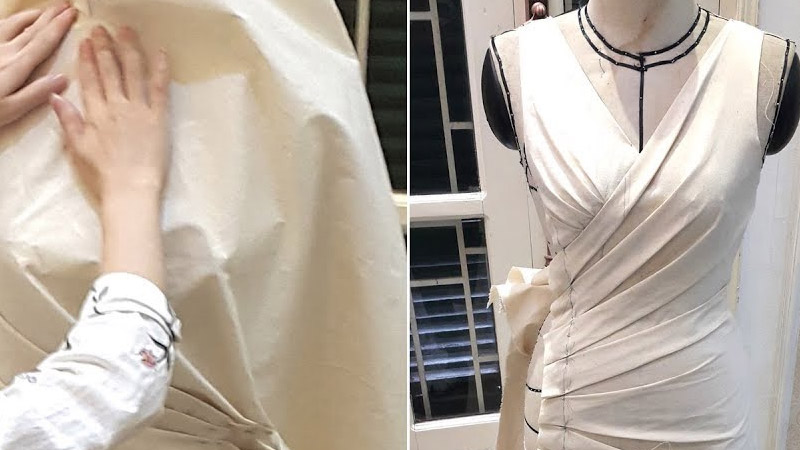
Pleats are created by folding fabric in a specific manner to create structured folds and lines. Designers use pleated draping to add texture, volume, and visual interest to garments, especially skirts and dresses.
Draped Necklines
Draped necklines involve manipulating fabric to create intricate and unique necklines, such as halter necks, sweetheart necklines, or one-shoulder designs. This technique can add drama and sophistication to a garment.
Artistic Draping
Some designers use draping as a form of artistic expression. They may create abstract or sculptural garments that push the boundaries of traditional fashion. Artistic draping is often seen in avant-garde or couture fashion.
Historical Draping
When recreating historically accurate garments or costumes, designers use historical draping techniques to mimic the clothing styles of specific time periods. These techniques require in-depth research and knowledge of historical fashion.
Draping for Couture
Couturiers often employ highly specialized draping techniques to create one-of-a-kind, custom-made garments for their clients.
These techniques may involve intricate handwork, fabric manipulation, and meticulous attention to detail.
Tailored Draping
This technique is used to create well-fitted, structured garments, such as tailored jackets and pants. It involves precise draping and pattern-making to achieve a tailored, professional look.
Wedding Dress Draping
Designers often use draping techniques to create luxurious and intricate wedding dresses. These designs may include cascading layers of fabric, intricate bodices, and delicate details.
Curtain Draping Techniques
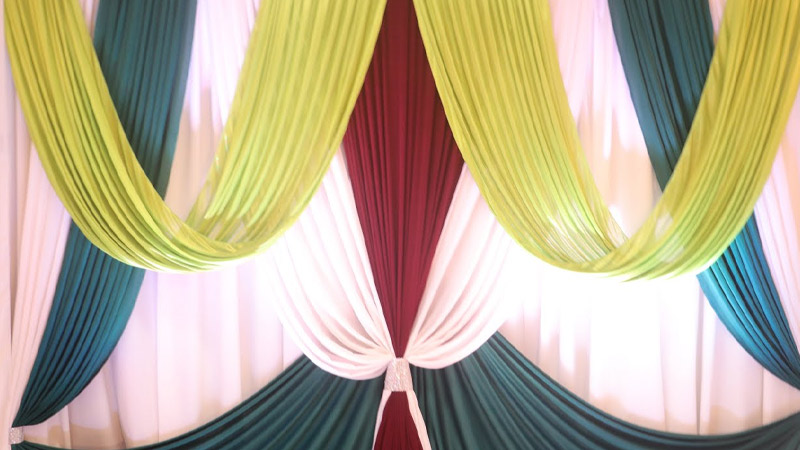
Curtain draping techniques are methods used to style and hang curtains to achieve various decorative and functional effects in interior design.
These techniques involve manipulating the fabric, arranging curtain hardware, and considering design elements to enhance the overall look and functionality of curtains.
Here are some common curtain-draping techniques:
Rod Pocket
In this classic draping technique, a rod is threaded through a pocket at the top of the curtain panel. It creates a clean and simple look, with the curtain evenly gathered on the rod. Rod pocket curtains are easy to slide open and close.
Tab Top
Tab top curtains have fabric loops or tabs sewn onto the top of the panel. These tabs are threaded through the curtain rod, creating a casual and relaxed appearance. Tab top curtains are known for their informal and decorative style.
Grommet Top
Grommet top curtains have metal or plastic rings evenly spaced along the top of the panel. The rings slide directly onto the curtain rod, creating large, even pleats. Grommet top curtains offer a modern and streamlined look.
Pleated Styles
- Pinch Pleat: Pinch pleat curtains have pleats evenly spaced across the top, creating a tailored and formal appearance. These pleats are typically secured with hooks or rings onto a traverse rod.
- Pencil Pleat: Pencil pleat curtains have small, tightly spaced pleats at the top, resembling the size of a pencil. They can be hung on a variety of rods, including traverse and cafe rods.
- Box Pleat: Box pleats are larger, squared-off pleats that create a structured and elegant appearance. They are often used in more formal settings and require more fabric than other pleat styles.
Swag and Jabot
Swag and jabot draping involves draping fabric valances or swags over the curtain rod to create a decorative and elegant look. Swags are the draped sections, while jabots are the cascading, vertical pieces.
Sheer Overlay
Layering sheer curtains over opaque or blackout curtains adds depth and texture to a window treatment. This technique allows for privacy while still allowing diffused light to filter through.
Curtain Scarves
Curtain scarves or swag valances are long pieces of fabric draped and arranged over curtain rods to create a graceful, flowing look. They can be used alone or in combination with other window treatments.
Curtain Rings and Clips
Using decorative rings or clips with curtains allows for easy adjustment of curtain length and appearance. This technique provides a flexible and versatile way to style curtains.
Tiebacks and Holdbacks
Tiebacks or holdbacks are used to hold curtains open and create decorative draping when curtains are not in use. They come in various styles, including fabric tiebacks, metal hooks, and decorative cords.
Layering and Mixing Styles
Combining different curtain styles, textures, and colors can create a unique and layered look for windows, enhancing both functionality and aesthetics.
FAQS
Can draping be used for all types of fabrics?
Draping is versatile and can be used with various fabric types, but the behavior of the fabric may vary.
Lightweight and flowy fabrics are often preferred for draping due to their ease of manipulation, but with skill, designers can work with a wide range of materials.
How does draping differ from flat pattern-making?
Draping involves shaping fabric on a dress form, while flat pattern-making starts with measurements and drafting patterns on paper.
Is draping limited to clothing design?
No, draping can be applied to other textile-based creations beyond clothing, such as home decor items like curtains, tablecloths, and upholstery.
Do I need a dress form to practice draping?
While a dress form is highly recommended for precision and experimentation, beginners can practice draping on themselves or on a friend as an alternative.
Can draping be combined with digital design techniques?
Yes, modern fashion designers often integrate digital tools and software with traditional draping techniques.
To Recap
Draping in sewing is not merely a technique; it’s an art form that empowers designers to bring their fashion visions to life.
This hands-on approach, involving the careful manipulation of fabric on a dress form, offers a level of creativity, fluidity, and precision that cannot be matched by traditional flat pattern-making alone.
Through draping, garments attain a unique synergy between design and construction, resulting in pieces that not only fit impeccably but also possess the graceful drape and structure that define fashion excellence.
Whether crafting everyday clothing or avant-garde couture, draping stands as a testament to the fusion of artistic expression and technical expertise within the world of sewing and design.
Leave a Reply